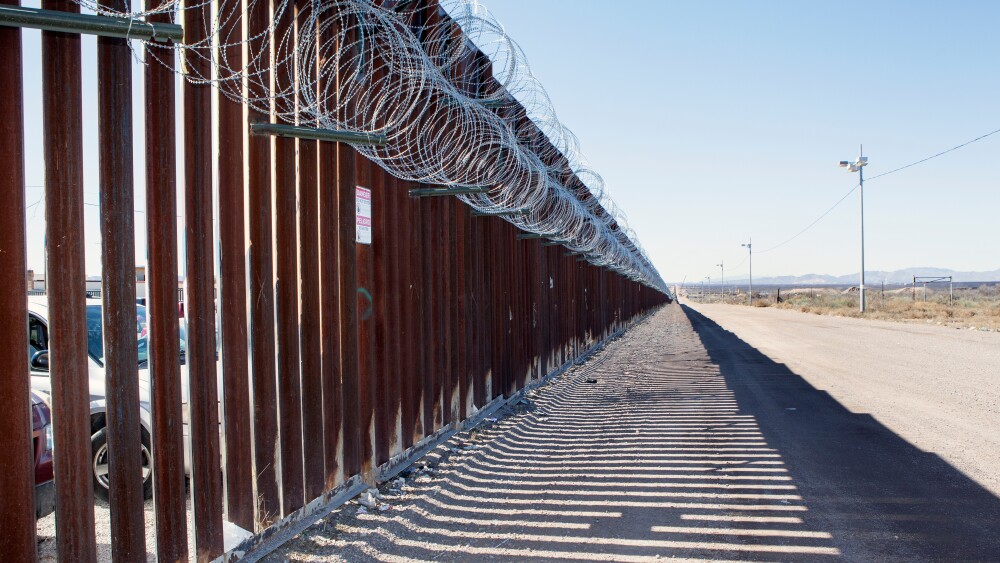Not so long ago, political opponents of 45th President Donald Trump deliberately misnamed one of his signature immigration policies the “Muslim Ban” and cast it as the poster child for all that that was racist, intolerant, and immoral about that presidency.
So terrible did Democrats regard the travel restrictions list — which sharply curtailed issuance of visas to anyone who hailed from 13 highly dysfunctional countries — that Joe Biden’s 2019-2020 presidential campaign reserved center stage real estate for it and proudly cancelled it on Inauguration Day 2021 in his “Proclamation on Ending Discriminatory Bans on Entry to The United States”, one of 17 executive orders.
But on his inauguration day as 47th president, Trump 2.0 signed the short but action-packed Executive Order “Protecting the United States From Foreign Terrorists and Other National Security and Public Safety Threats”, which sets the stage for the travel ban’s return as a bigger and more expansive iteration of its controversial ancestor. Surprisingly, given its tumultuous political past, this lightning rod of an immigration-related national security policy has escaped almost any media attention and analysis.
Its return should not surprise anyone, as Trump on the campaign trail often promised he would reinstate his “famous travel ban”.
“I will ban refugee resettlement from terror infested areas like the Gaza Strip, and we will seal our border and bring back the travel ban,” Trump promised, for instance, at a September 2024 speech. “Remember the famous travel ban? We didn’t take people from certain areas of the world? We’re not taking them from infested countries.”
Its return should not surprise anyone, as Trump on the campaign trail often promised he would reinstate his “famous travel ban”.
But now we have the follow-through and details of that promise, found in this executive order.
For starters, this highly consequential executive order is all about re-emphasizing national security screening and “vetting” to weed out Islamist terrorists and other forms of undesired public safety threats from among the millions of foreign nationals who annually apply for immigrant and non-immigrant visas of all kinds, from refugees to tourists, while they are still abroad. (See “Decoding Trump’s Border Counterterrorism Order Part, 2”). But unusually and almost certainly controversially, it also puts the world on notice that the United States intends to backdate the vetting check to deport many already let into the country, such as pro-Hamas demonstrators at college campuses, as “Decoding Trump’s Border Counterterrorism Order, Part 1” explains.
The order sets the table for the new travel ban by generally declaring the United States will “vet and screen to the maximum degree possible all aliens who intend to be admitted, enter, or are already inside the United States, particularly those aliens coming from regions or nations with identified security risks”. (Emphasis added.)
The main clue that the travel ban is authorized here to return in a bigger and more expansive way comes soon after in Section 2(b). It directs the secretary of State, attorney general, secretary of Homeland Security, and the director of national intelligence to, by March 1, identify “countries throughout the world for which vetting and screening information is so deficient as to warrant a partial or full suspension on the admission of nationals from those countries”.
And this part is new: The United States national security enterprise, the order commands, will endeavor to locate foreign nationals from that list who were already admitted into the country in recent years, and deport them.
The order commands that, once those countries are identified and submitted to an “Assistant to the President for Homeland Security” the nation’s top national security leadership “take immediate steps to exclude or remove that alien” when information supports “exclusion or removal”. Unless removal gets in the way of an active investigation, of course.
A Vastly Misunderstood but Sensible Security Policy
Trump’s political opponents so often misconstrued the real purpose of his “famous travel ban” that most Americans probably still have no idea what it did and why his administration deems it so necessary.
The travel ban addresses a real national security problem, which is to significantly reduce the issuance of visas to people from countries of terrorism concern or other public safety concerns that don’t, won’t, or can’t cooperate with American security-vetting processes that are at the heart of Trump’s border counterterrorism directive.
Consider for a moment how American security vetting officials would check the backgrounds of foreign nationals from the original 13 countries that were on that list: Iran, Libya, Somalia, Sudan, Syria, Yemen, North Korea, Myanmar, Eritrea, Kyrgyzstan, Nigeria, Venezuela, and Tanzania. In Libya, there is no government to ask for security information. For 30 years, Somalia has had no government at all to issue birth certificates, driver’s licenses, or to arrest criminals and terrorists.
Trump’s political opponents so often misconstrued the real purpose of his “famous travel ban” that most Americans probably still have no idea what it did and why his administration deems it so necessary.
How would American screeners ever be able to phone North Korea’s infamously adversarial dictator for help on anyone asking to enter the United States from that benighted nation? How about Syria, whose last government was listed as a state sponsor of terrorism and, in alignment with Iran and Hezbollah, officially hated the United States and probably would have loved to see it attacked. Now, an al-Qaeda aligned terrorist group has taken over Syria. And Yemen is run by an America-hating, Iran-backed designated terrorist group called the Houthis that the U.S. Navy and Air Force have repeatedly attacked in recent months.
Some countries are simply on the list because they have gone entirely ungoverned for years and therefore have no useful information to share with Americans asking for intelligence information or criminal history.
Take Sudan. Whether South Sudan or regular Sudan to its north, since the country’s fuzzy political partition into two countries some years ago, the whole region is pre-modern, an almost ungoverned morass of tribal hatreds and conflicts where toilets, let alone computer databases, are in short supply and police and intelligence services are uninterested in anything beyond keeping this or that patron leader in power.
None of this should be hard to understand as a rationale for sharply limiting the entries of people from these countries who can’t be reliably vetted for past involvements with local anti-American, atrocity-committing militias and designated terrorist groups that operate in those countries.
A List Almost Certain to Expand by Leaps and Bounds
Indeed, because times have changed since the first version of travel ban was in effect, the incoming administration will almost certainly expand the original list of problematic countries beyond the 13 that were last on it. And it will vastly expand the workload on U.S. investigators who will be tasked with back-vetting aliens from those countries already let into the United States.
Trump has already named Gaza, of course, and there’s the West Bank, too.
But there are many other worthwhile candidates. Since the travel ban was last in effect, for instance, Afghanistan has changed hands from a U.S.-backed friendly government to the hostile U.S.-designated terrorist group known as the Taliban, which would not likely be willing to help suss out possible terrorists applying for U.S. visas.
There’s the Democratic Republic of Congo, a premodern state wracked by civil war, infested with a significant ISIS franchise and atrocity-committing militias, and probably having useless record-keeping systems on anyone, let alone criminals.
Tajikistanis have conducted horrific terror attacks in Russia and Europe and were the targets of a major FBI counterterrorism sting investigation inside the United States last year that resulted in the arrests and deportations of eight Tajiks let in over the southern border. The U.S. let in at least one over the southern border as part of the CBP One humanitarian parole application process, which Biden administration officials swore provided robust security vetting.
In October 2024, one of some 20,000 Mauritanian illegal border-crossers who have entered in recent years staged a wild terror attack on an Orthodox Jewish neighborhood in Chicago, wounding one Jewish man before police shot and wounded him. (See “First Blood” series, parts 1-3, CIS, January 2025.)
Perhaps most interestingly, some new countries will likely join the list for reasons having nothing to do with international Islamic terrorism. We can expect this because the executive order commands that DHS consider countries if their citizens can’t be screened for certain unspecified “public safety threats”.
Perhaps most interestingly, some new countries will likely join the list for reasons having nothing to do with international Islamic terrorism. We can expect this because the executive order commands that DHS consider countries if their citizens can’t be screened for certain unspecified “public safety threats”.
No one can yet say how that part of the order ends up expanding the list, but one might imagine, for instance, that U.S.-adversarial Venezuela would remain on the list for a new reason, because thousands of vicious “Tren de Aragua” gangsters from that country made their way over the southern border into 17 U.S. states in recent years.
El Salvador might wind up on the list, given the prevalence of MS-13 gang members who have crossed, too.
And most potentially interesting would be China, whose spies have been caught and prosecuted posing as students and researchers so they could exfiltrate cutting edge defense-related U.S. technology and research. And whose citizens have crossed the southern border in recent years by the tens of thousands. (See “Bensman congressional testimony before the House Homeland Security Committee, Subcommittee on Oversight, Investigations and Accountability”.)
An Ample Record of Cases a Travel Ban Could Have Prevented
The new administration has given itself a lot of work with this ambitious executive order, particularly the directive that adjudicators back-vet foreign nationals who are already present.
But many past cases of terrorists caught from countries on the original list and good candidates for the new one suggest the program will prove to be effective.
Take, for example, the 2018 terrorism case in which federal prosecutors charged a Somali refugee couple resettled in Tucson with 11 counts of repeatedly lying about everything, including even their names, on their initial 2013 refugee applications in ungoverned Mogadishu and later on their permanent legal residency applications in Tucson.
Most notably, though, Mohamed Abdirahman Osman and his wife Zeinab Abdirahman Mohamad never let on that he was an al-Shabaab terrorist fighter, as was his brother and entire extended family. Nor that he provided aid and $32,000 in support to the brother after the brother coordinated a May 24, 2014, suicide bombing of a Djibouti restaurant and became an international fugitive.
U.S. taxpayers would have been spared the danger and prosecution expense had Trump’s travel ban been in place then.
Consider the case of Gaafar Muhammed Ebrahim Al-Wazer, 25, a Yemeni who made legal entry into the United States in 2014: He swore on his visa applications while in front of an American officer in the U.S. embassy that he had no affiliations with the Houthi rebels.
U.S. taxpayers would have been spared the danger and prosecution expense had Trump’s travel ban been in place then.
Not long after he settled in Altoona, Pa., the FBI learned via a tip that Al-Wazer had fought with the rebels and was posting all about it on social media. He allegedly unburdened himself of increasingly fervent hatreds on his Facebook page, where he wished “death to all Americans, especially Jews”, and vowed he would stay on the path of violent jihad.
The Bureau found online photos showing a heavily armed Al-Wazer and his brother with the Houthi rebels in Yemen.
Consider the more recent case of Afghan national Nasir Ahmad Tawhedi, a former CIA office guard in Afghanistan who came in among 100,000 Afghan evacuees on special immigrant visas during the Biden administration and now stands charged with plotting a violent election day attack on behalf of ISIS. Government investigative reports say that many of those Afghans later were discovered to be unacceptable terrorism security risks. Biden administration officials said they’d thoroughly vetted Tawhedi three different times but later admitted he’d never been vetted by anyone.
Then there was the terrorism case against 21-year-old Sudanese citizen Mahmoud Amin Mohamed Elhassan, who entered the United States with his siblings on legal permanent resident visas. At the time, Sudan was a U.S.-designated state sponsor of terrorism and would not have been willing — or, frankly, even able — to provide American adjudicators with any intelligence or background history about Elhassan for a thorough security vetting.
Within a year of his arrival, Elhassan was on social media espousing violent, anti-American jihad under a pseudonym, according to court records from his later terrorism prosecution. The FBI got on to him in late 2015 and by 2016, just before Trump was elected and shuttered almost all visas for Sudan under his travel ban, Elhassan pleaded guilty to plotting with a co-conspirator to “chop heads” with ISIS in Syria. Shortly before Trump implemented the travel ban, a Virginia judge sentenced him to 11 years in prison on terrorism charges.
These few cases are among many others that, had a travel ban like Trump’s been in place, may never have happened.








